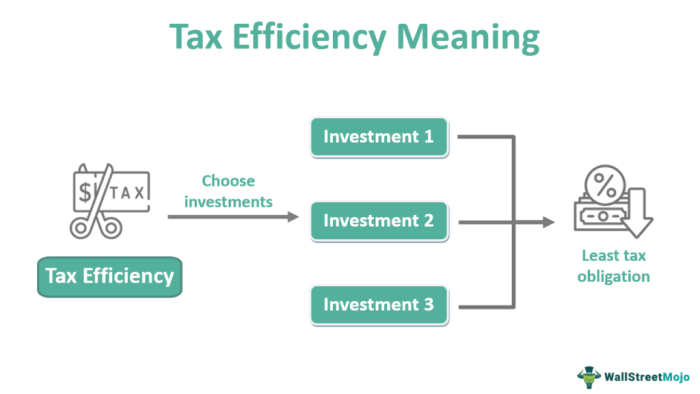Get ready to dive deep into the world of Tax-efficient investing. This topic isn’t just about numbers and strategies; it’s about maximizing your returns while minimizing those pesky tax liabilities. So buckle up, because we’re about to take you on a wild ride through the realm of tax-savvy investing.
In the following paragraphs, we’ll break down the key concepts of tax-efficient investing, explore its benefits, delve into different strategies, and provide essential tips to help you navigate this financial landscape like a pro.
What is Tax-efficient investing?
Tax-efficient investing refers to the strategy of minimizing the tax impact on investment returns by managing investments in a way that reduces the tax liability.
Importance of Tax-efficient investing
Tax-efficient investing is crucial for maximizing overall returns on investments. By minimizing taxes, investors can keep more of their earnings and potentially grow their wealth at a faster rate.
Examples of Tax-efficient investment strategies
- Utilizing tax-advantaged accounts such as IRAs and 401(k)s to defer or avoid taxes on investment gains.
- Harvesting tax losses by selling investments at a loss to offset capital gains and reduce taxable income.
- Investing in tax-efficient funds that have lower turnover and therefore generate fewer capital gains distributions.
- Consider holding investments for the long term to benefit from lower long-term capital gains tax rates.
Benefits of Tax-efficient investing

Tax-efficient investing offers several advantages that can help investors maximize their returns and minimize tax liabilities. By strategically managing investments to reduce the impact of taxes, individuals can potentially achieve higher after-tax returns compared to traditional investing methods. Let’s explore some key benefits of tax-efficient investing:
1. Reduced tax drag
Tax-efficient investing aims to minimize the tax drag on investment returns by utilizing strategies like tax-loss harvesting, holding investments for the long term to benefit from lower capital gains tax rates, and investing in tax-advantaged accounts like IRAs and 401(k)s. By reducing the amount of taxes paid on investment gains, investors can retain more of their earnings and potentially grow their wealth faster.
2. Compound growth
Through tax-efficient investing, investors can harness the power of compounding to accelerate wealth accumulation. By reinvesting tax savings back into the investment portfolio, individuals can take advantage of exponential growth over time. This compounding effect can lead to significant wealth accumulation over the long term, allowing investors to achieve their financial goals more efficiently.
3. Minimized tax liabilities
Tax-efficient investing strategies help minimize tax liabilities by optimizing the timing of investment transactions, utilizing tax-advantaged accounts, and strategically allocating assets to reduce tax exposure. For example, investing in municipal bonds can provide tax-free income, while utilizing retirement accounts can defer taxes on investment gains until withdrawals are made. By carefully planning and executing tax-efficient strategies, investors can keep more of their money working for them and less going to the taxman.
Tax-efficient investment strategies
Tax-efficient investment strategies are crucial for maximizing returns while minimizing tax liabilities. By strategically managing investments, individuals can reduce the impact of taxes on their overall portfolio growth.
Long-term vs. Short-term Tax-efficient Investment Strategies
When it comes to tax-efficient investing, the holding period of an investment can significantly impact the tax treatment. Long-term investment strategies involve holding investments for more than a year to qualify for lower long-term capital gains tax rates. On the other hand, short-term strategies focus on quick trades or investments held for less than a year, subject to higher short-term capital gains tax rates. By understanding the tax implications of holding periods, investors can choose the most tax-efficient approach based on their financial goals.
Asset Location Impact on Tax Efficiency
Asset location plays a vital role in optimizing tax efficiency within an investment portfolio. By strategically placing investments in taxable or tax-advantaged accounts, investors can minimize tax liabilities. For example, placing tax-inefficient investments like bonds, which generate regular income, in tax-advantaged accounts can help defer taxes on interest income. Conversely, tax-efficient investments such as stocks, which have lower tax implications, can be held in taxable accounts to take advantage of lower capital gains tax rates. Strategic asset location can enhance overall tax efficiency and improve after-tax returns for investors.
Considerations for Tax-efficient investing
When it comes to tax-efficient investing, there are several key factors to consider in order to maximize your investment returns while minimizing tax liabilities. Diversification and strategic planning play a crucial role in achieving tax efficiency in your investment portfolio.
Factors to consider when choosing tax-efficient investments
- Consider the tax implications of each investment: Different types of investments, such as stocks, bonds, or real estate, have varying tax consequences. It’s important to understand how each investment will be taxed and factor that into your decision-making process.
- Look for tax-advantaged accounts: Utilize retirement accounts like IRAs or 401(k)s, which offer tax benefits that can help reduce your overall tax burden.
- Consider the holding period: Capital gains taxes are typically lower for investments held for longer periods. Keeping investments for the long term can help minimize tax liabilities.
How diversification plays a role in tax-efficient investing
Diversification is key to spreading risk across different asset classes, which can help reduce the impact of market fluctuations on your overall portfolio. From a tax perspective, diversification can also help optimize tax efficiency by offsetting gains with losses and taking advantage of different tax treatments for various investments.
Tips on how to optimize tax efficiency in an investment portfolio
- Harvest tax losses: Selling investments at a loss can help offset capital gains and reduce your tax liability. This strategy, known as tax-loss harvesting, can be a valuable tool for optimizing tax efficiency.
- Consider tax-efficient funds: Look for investment funds specifically designed to minimize tax consequences, such as index funds or ETFs that have low turnover and tax-efficient strategies.
- Stay informed and seek professional advice: Tax laws and regulations are constantly changing, so it’s important to stay up-to-date on the latest developments and consult with a tax professional to ensure you are making the most tax-efficient decisions for your investment portfolio.
